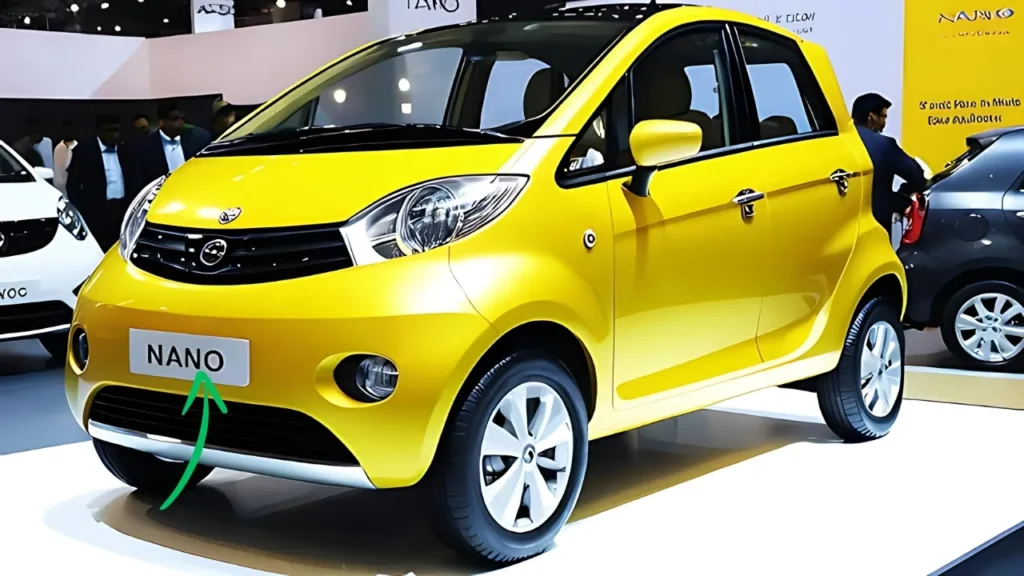Tata Nano EV: In the dynamic world of electric vehicles, Tata Motors is all set to change the game of affordable mobility. Tata Nano EV (to be launched in 2025) is more than just a vehicle, it represents a bold vision to liberate electric mobility into the dreams of millions of Indians. With this truly innovative car, it will be possible to extend the tradition of the simple Nano and best address the most critical topics of urban mobility, environmental sustainability, and a)economic accessibility. Due to its own special concept and reason behind the pricing strategy adopted, the Nano EV is giving a new dimension to the concept of electric mobility in the country and by furthre opening up the access to a different layer of society, this country may even change the perception of electric mobility.
The Genesis of an Electric Dream
From People’s Car to People’s Electric Car
The first generation of the Tata Nano attracted global eyeballs as the most affordable vehicle available on earth, an iconic example of revolutionary mobility thinking in India. Similarly, Nano EV is intended to have an even wider reach by delivering electric vehicle capabilities to the public sphere. Tata Motors has scaled up an idea initially intended as disruptive to a model that has also become disruptive in the context of sustainable urban mobility. Based on decades of research, development, and consumer understanding, the company has introduced a vehicle that satisfied not only the essential functionality of transportation but also the increasing environmental interest of contemporary consumers.
Key Specifications at a Glance
- Expected Price Range: ₹3 to ₹5 lakh
- Estimated Range: 150-200 km on a single charge
- Production Facility: Sanand, Gujarat
- Initial Production Capacity: Approximately 50,000 units annually
- Battery Warranty: Expected 8 years or 160,000 kilometers
- Charging Time: 0-80% in approximately 60 minutes with fast charging
- Top Speed: Expected 120 km/h
- Motor Power: Estimated 30-40 kW
- Engineering Innovation: More Than Just an Affordable EV
Powertrain and Performance
Certainly it is not just a cheap electric car, the Tata Nano EV is a technology-advanced engineered vehicle. Installed with high-performance electric engine, the car has been re-designed to deliver sufficient power for urban traffics with a high ediency. Integrate with regenerative braking technology it is ensured that every and any brake application extends the range life of the vehicle at the cost of increasing the energy spent in vehicle management system.That sets the example of intelligent energy efficiency by Tata. The high performance thermal management system optimizes the battery operation at an ideal temperature range so that the permanent operation under any weather and the reduction of the battery consumption are accomplished. Thanks to the compact design and aerodynamic properties of the vehicle, its remarkable range and energy efficiency are possible, and so is a vehicle design that is.
Smart Features for the Modern User
- Smart infotainment system with 7-inch touchscreen display
- Bluetooth connectivity with voice command support
- Android Auto and Apple CarPlay integration
- Essential safety features including dual airbags
- ABS (Anti-lock Braking System) with EBD
- Reverse parking sensors with camera
- Connected car features via smartphone app
- Real-time battery monitoring system
- Over-the-air software updates capability
- Multiple driving modes for optimal efficiency
- Environmental and Economic Impact
Addressing Urban Pollution
Tata Nano EV is an important step to urban pollution reduction. Targeting a market that is hungry for green transportation in India’s urban sprawl, Tata Motors intends to drive the electrification of older, polluting vehicles in India’s crowded cities by providing an affordable electric option. The environmental benefits are significant each Nano EV driving in the streets helps to create cleaner air and less carbon dioxide emissions. There is evidence suggesting a broad deployment of vehicles powered by electric motors – e.g., car Nano EV can significantly reduce urban air pollution, lead to a better health of the population and reduce costs associated with the treatment of diseases caused by air pollution.
Driving Economic Transformation

- Job creation in manufacturing and assembly
- Skill development in EV technology and maintenance
- Reduced dependence on imported oil
- Acceleration of India’s electric mobility ecosystem
- Growth in charging infrastructure development
- Boost to local component manufacturing
- Development of recycling and battery disposal facilities
- Development of service business models in electric vehicles (EV) service.
- Market Positioning and Competitive Landscape
Targeting the Mass Market
The market positioning of the Nano EV results from Tata Motors’ thorough knowledge of the Indian consumer’s psychological and behavioral needs and desires. Introducing an electric vehicle at a price level that is on a par with the prices of “entry-level” petrol vehicles, the company intends to provide electric mobility to a larger consumer group. Not only does this positioning overcome the cost issue but also enables faster commercialization of the electric vehicles to the price-conscious Indian consumer segment.
As opposed to the high-end electric vehicles, which are currently beyond the financial capacity of the majority of Indian consumers, the Tata Nano EV is carefully positioned to play a role in the low-end electric vehicle sector transformation. The vehicle is carefully crafted to attract both novice EV buyers and price-conscious buyers who for years have yearned for a low-cost, electric-powered lifesaver concept. Thanks to its intelligent design, very small size, which all makes it ideal for habitation in india, very densely populated urban setting, and attractive price point, it is definitely its own in the current on market competition (Mahindra e2o Plus and Maruti Suzuki WagonR EV). The ability of the vehicle to be large or small, combined with its manouverability, fits in not just the city centre but also in the narrow spaces, which is the main concern for a large part of urban Indian drivers.
Government Support and Incentives
Fulfilling a propitious time is the arrival of Nano EV, indeed, it is the perfect time, as, it is matching with the stratagem of the Indian government to provide Clean cars. The multifaceted EV policy framework developed by the government, in the form of the FAME II scheme (Faster Adoption and manufacturing of Electric Vehicles), provides immense push for electric vehicle adoption. Potential buyers may be eligible for different financial benefits such as purchasing subsidies at the national and state levels, decreased rate of GST, and exemption from road tax, several states. [Having] sufficient [incentives], this can be used to further slim the current relatively inexpensive Nano EV [and even] reach a true 15-20% reduction in cost. Moreover, some of the states are providing extra benefits such as free parking and toll waivers, in addition to a preferential price for EV charging, further enhancing the economic ownership experience for the consumers.
Future Prospects and Potential Developments
Beyond the 2025 Launch
Tata Motors vision goes hollow deep than just launching another car in their catalogue, they areestablishing step by step the infrastructure of a complete electric mobility ecosystem. Some of the ways in which the future evolution of the Nano EV’s function and user interaction can be improved are shown through the company roadmap. These encouraging progress takes place in several technological and functional levels of the car, including the realization of high-range versions to solve the problem of range anxiety, the naturally integrated evolution of advanced smart home systems within the car to perform vehicle home ride-sharing between the car and home infrastructures, occasionally over-the-air system updates in order to constantly keep vehicle performance optimal and maintain vehicle functionalities, and progressive realization of driverless driving (hereinafter referred to as DLA) in a loop with developing technologies and legal regulations of them.
Challenges and Opportunities
Infrastructure and Adoption
Since the Tata Nano EV is a promising step toward cost effective electric vehicles, there are a number of major issues that need to be overcome to ensure its successful market adoption [29, 30, 31, 32, 34, 35, 37]. Vehicle success, say, will be highly dependent on many of the factors that will need concerted action from a range of stakeholders. It is most acutely linked to fulfilment of the promise of charging service expansion for urban and rural areas, whether in public charging stations or domestic charging solutions. This kind of infrastructure development cannot be realized at the same time as the increasing number of EV whose operation is only possible when the users are not afraid of “charging.
Equally important is a generalized consumer demand for facts about electric vehicles, to dismiss some of the biggest misconceptions, such as misconceptions about range and charging time, the durability of the battery, and maintenance requirements, etc. Unfortunately, a significant number of potential buyers currently hesitate, for good reasons, about the practicality and reliability of electric vehicles, and thus, targeted awareness campaigns and demonstrative experiences are greatly needed.
As the evolution of EV technology deepens, especially in battery energy efficiency and charge rates, it will exert a big influence to upgrade the user experience as a whole. Tata Motors will have to strike that compromise between low cost and technological leap for the Nano EV to remain in a position of competitiveness and desirability towards its target consumers.
Furthermore, sustained government support for EV adoption through policies, incentives, and infrastructure development will be crucial. This includes not only financial rewards, but also regulatory structures that encourage penetration of EVs while maintaining both the safety and quality of the hardware.
Conclusion: A Milestone in Electric Mobility
The launch of Tata Nano EV is not just another car in India, but rather a much more profound endorsement of India’s technological prowess and its unyielding commitment towards green transportation solutions. Telecom Corporation of India Ltd is making electric vehicles that are affordable and accessible to the mass Indian consumer, and the “electrified” stock is not just selling a product; it is promoting a clean and sustainable future of transportation for the Indian population.
On the other hand, while the Nano EV struts towards the realized arrival of this type of car on Indian roads, it is the dream and aspiration of tens of millions of potential customers to possess a low cost, eco-friendly vehicle mobility technology – without compromise in performance quality or technical superiorities. The electric revolution is no dream of the future, with the launch of the Tata Nano EV, it is becoming a reality for all Indians.
The Road Ahead
The Tata Nano EV journey has at last started, hence the beginning of a new mobility paradigm for Indians. As it is about to navigate India’s diverse and intricate geographical landscape, it is more than just a means to an end, it is more than this. The structure is a lighthouse on sustainable mobility, a demonstrator of Indian engineering excellence and innovation, and, more importantly, it serves as a yardstick for showcasing the ingenuity of making affordable, sustainable technology change people’s lives and their communities across the country.

